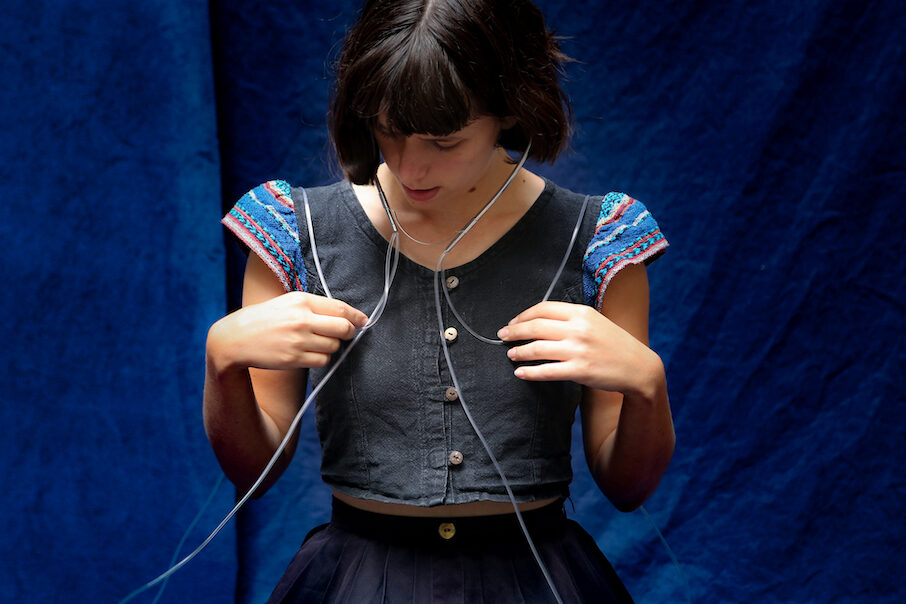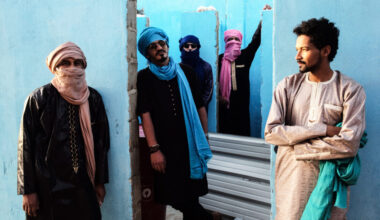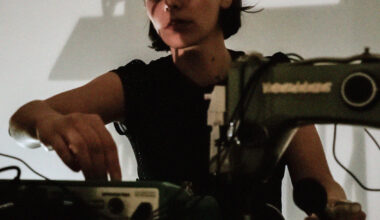Veritas Ventriloquist originates as a sonic performance with the Veritas Machine – a noisy, dynamic interface comprised of dismantled and reforged sewing machines, re-envisioned as an instrument and vocal synthesiser. The publication includes a music release, a printed visual anthology, and a web-based archive of videos, images and text-based research. The release event will feature Sebes’ performance of the work, joined by Annette Krebs with her piece Konstruktion#4, an electroacoustic composition assemblage of metal pieces, strings, sound objects, microphones, computers, tablets and sensors, sonically transformed in real time.
Mote Studio and Digital in Berlin is proud to announce the performance and publication launch of Lottie Sebes’ Veritas Ventriloquist on March 26th at Morphine Raum.
FACTS
1. The first models of typewriters could be seen as experiments in building a technological association with the feminine, of designing gender into machines. They were given aesthetic and functional links to machines which were already used by women like cast-iron decorated bases resembling sewing machines, foot pedals, and even piano-like keyboards. This lent credibility to the idea that typing was a ‘feminine’ role, making it easier to fill secretary positions with lower-paid female employees. In this way, the violence of gender inequality in the labour market has been built into the tools of the trade for centuries.
2. The standard single-pedal design of the sewing machine is a result of a debate conducted by male doctors and unionists in the 1860s. Dr. Eugène Guibout claimed that the operation of the bi-pedal machines of the time was sexually pleasurable for women, which was deemed to produce ‘symptoms’ such as weakness, fatigue, weight-loss and vaginal discharge, illustrating “the ravages produced by an involuntary masturbation resulting from the play of the machine”. In this way, strong opposition to women’s entry to the modern non-domestic labour force was veiled behind moral panic surrounding their sexuality. The design of the machine we use today perpetually manifests a history in which women’s bodies have been feared and controlled.
3. “Machines are never neutral. They are always already entangled in gendered, radicalized and sexualised regimes of truth, saturated with (asymmetrical) power relations” (Lisa Rahm and Jörgen Rahm-Skågeby)
QUESTIONS
1. Ventriloquism has historically been understood as not just a throwing of a voice, but also the raising or conjuring of voices of the deceased. Whose voice, or truth, are you letting speak through the veritas machine?
Although I make no vocal sound of my own in this work, and while I call on the perspectives of generations of women from the past, this is my performative claim to existing entanglements of gender and technology in the archive of media history. I want to re-voice the perspectives which are already ossified in the machine’s gears, bolts and cables. By resonating the noise of the motor through the chamber of my mouth, I want to create a shared agency – mirroring the way our conceptions of bodies and machines have be shaped by each other over time.
2. In part of your performance, a cyborg voice declares the veritas machine to pulse with the “womanly virtues of speed and ferocity”, before expressing “what a wonderful new feeling.” What do you feel when you perform the piece?
I feel scared and powerful
3. What samples/tape recordings are being interacted with in the performance?
The archival recordings on the tape loop were taken from a range of sources: historical advertisements, demonstration films, public service announcements and educational films about women’s health and employment. With this sound collage, I want to expose and satirise the contradictions and tropes in the discourses surrounding women’s operation of machines.
4. Do you see other versions of the veritas machine being made in the future?
I can imagine this work being developed and expanded for sure, as it has been over the last two years. Equally, this practice of sampling and re-appropriating tools from the history of technology to build new instruments is a practice I like to engage in and am already exploring this in other works.
5. Can you tell us about the printed visual anthology that is a part of the project; as well as what you found in your archival research?
In collaboration with Davide Luciani and Mote Studio, the performance is being expanded into a wide constellation of media. The visual anthology is one part of this, along with a music release, and a web-based archive of videos and written research. More than simply documenting the project, this collection tries to abstract and expand the different aspects of Veritas Ventriloquist and my process of creating it. To create the visual anthology, Davide Luciani has taken the archive of images I collected throughout my process – of bodies, machines and voices being conditioned by each other – and has created a kind of visual atlas which allows for free-flowing associations between these elements. It’s an experiment in presenting artistic research, of collecting and sharing knowledge using still visuals alone. The starting point for this publication was the desire to extract a recording from the performance, distilling it to music alone. This was honestly something I had never contemplated doing before as I have no background in noise music, but as always, the process of recording and mixing the piece offered a new creative front in itself and I’m happy to say that I feel the work as blossomed out of this transformation. In the web-based part of the publication, I document my artistic research in another way – as an extended text and video archive. This text outlines the theoretical and historical research I undertook into the history of technologies which were predominantly used by women in the 19th and 20th centuries, and describes my studio-based process of discovering ways to performatively re-claim this history. If I had to sum up what I found in this research, I would use the words of Donna Harraway, that “technologies…can be partially understood…as frozen moments, of the fluid social interactions constituting them, but they should also be viewed as instruments for enforcing meanings.”
6. How and when did you get into making music and art?
I’ve been playing music since I was a small child. Much of my childhood and teenage years were spent in violin and saxophone lessons and playing in ensembles and orchestras. But when I went on to study painting and sculpture at art school, my focus started to shift towards an approach to sound which comes from a contemporary art perspective. Although I’ve ultimately crafted an instrument and a composition with this work, my attention has been just as focussed on the performative aspects, visual aesthetics and of course, the research.
7. What is the biggest inspiration for your work?
Machines I never knew existed. My most exciting flashes of inspiration have happened as I explored the dusty sheds and basements of my hoarding family members, stared into vitrines in museums of technology and musical instruments, flicked through the pages of books filled with technical diagrams or hunted for treasure in crowded flea markets.
8. What do you associate with Berlin?
Anonymity, friends, the cold, Späti beers, bureaucracy, the forest, music…
9. Who would you most like to collaborate with?
At this point in time, the Danish composer and sound artist Sandra Boss.
10. What was your most important performance/exhibition (as artist or audience member)?
The City of Forking Paths at the 19th Biennale of Sydney by Janet Cardiff and George Bures Miller was quite a life-changing work for me to experience. I think I went back and did the sound walk three or four times.
11. How important is technology to your creative process?
It’s crucial. In my creative work, I like to not only think about technologies, but to think with and through them, as embodiments of ideas which can feed, process and transform each other.
I’ll try to explain: I have a fascination with objects, sounds and images from the past and I believe these things can connect us as humans across time. Machines and technologies, as extensions of our bodily capacities, are in this sense a particularly rich kind of object for me. When we design a new tool, we show a desire to do more than we can do, to be more than we are, to extend the possible. The machine becomes the embodiment of an idea and a dream which was shaped by society and in turn, the tool may go on to shape society. For me, to study a machine is to get closer to that desire, to access the dreams of a person, a group or a society, to discover where the edge of the possible was for them.
In my work, I re-forge, re-design and re-shape these embodiments of ideas to make them my own, to re-voice the aspects of their conditioning which may have been forgotten. I hope to illuminate what they may have meant to different people at different moments in time, to voice what they mean to me and to speculate on how they could come to shape – and be shaped in – the future.


